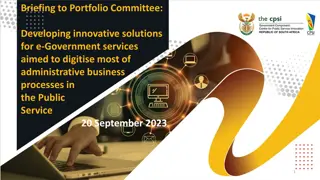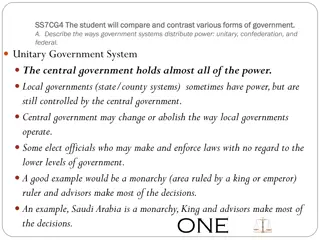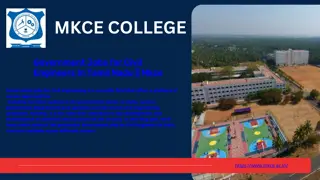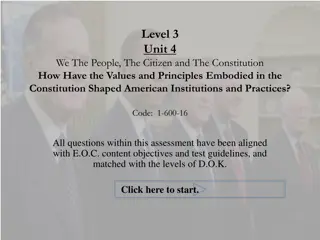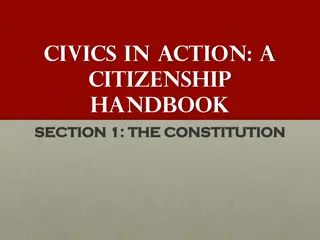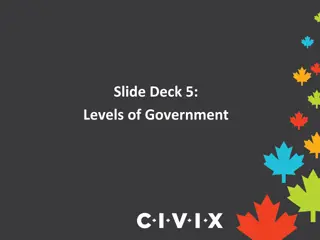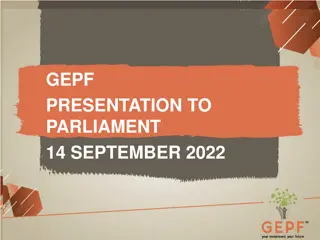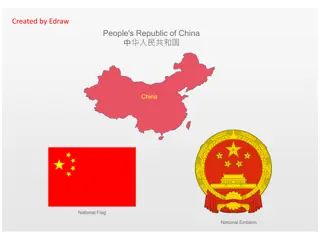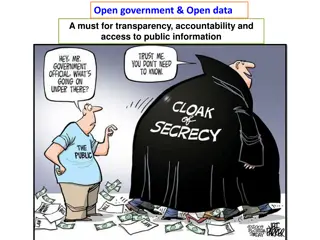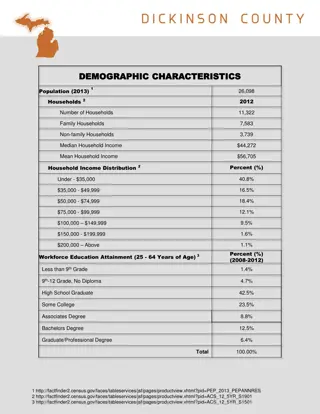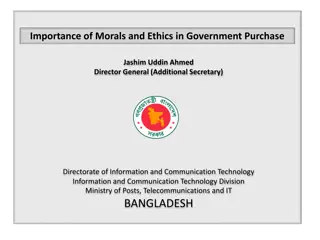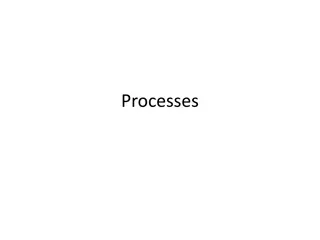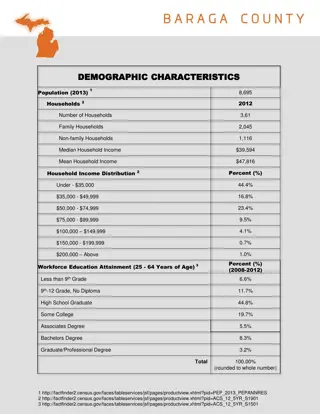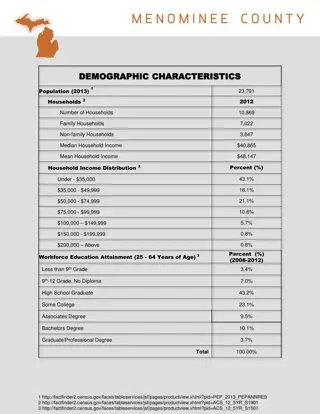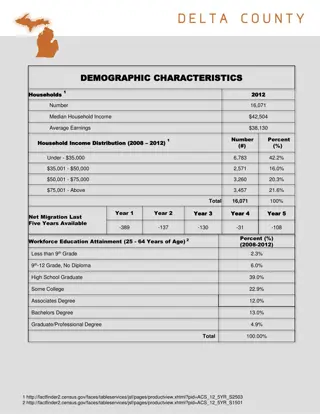Overview of U.S. Government Structure and Processes
This presentation provides an insightful overview of the power centers in the U.S. government, focusing on the roles and functions of key branches and institutions such as the Executive, Legislative, and Judicial branches. It also delves into the mechanisms through which policies and strategies are defined and executed at the national level.
Download Presentation

Please find below an Image/Link to download the presentation.
The content on the website is provided AS IS for your information and personal use only. It may not be sold, licensed, or shared on other websites without obtaining consent from the author.If you encounter any issues during the download, it is possible that the publisher has removed the file from their server.
You are allowed to download the files provided on this website for personal or commercial use, subject to the condition that they are used lawfully. All files are the property of their respective owners.
The content on the website is provided AS IS for your information and personal use only. It may not be sold, licensed, or shared on other websites without obtaining consent from the author.
E N D
Presentation Transcript
The views expressed are the authors personal views and do not necessarily reflect official DoD policy. How Washington Works: Understanding the U.S. Government s Power Centers Washington Embassy Orientation 18 October 2021 Michael S. Bell, Ph.D. Near East South Asia Center for Strategic Studies Former Special Assistant to the President for National Security Affairs & Senior Director for Middle East Affairs, National Security Council
Who Defines U.S. Policy and Strategy? The President and the National Security Council process Desktop Wallpaper-s > Landscapes > US Capitol Building at Night, Washington DC The Congress Precedent and History Strategic Culture 2
U.S. National Government (117th Congress, 2021-2023) U .S . C O N S T IT U T IO N (7 A r tic le s , 2 7 A m e n d m e n ts ) L e g is la tiv e B r a n c h E x e c u tiv e B r a n c h J u d ic ia l B r a n c h THE PRESIDENT VICE PRESIDENT (Both Elected Nationally to 4-Year Terms but Limited to Two Terms) Executive Office of the President SUPREME COURT LOWER COURTS (Appointed for Life) HOUSE of REPRESENTATIVES (435 1 per 716,000 Constituency, elected to 2-Year Terms) SENATE (100 2 per 50 states, elected to 6-Year Terms) 15 Departments 60+ Agencies and Gov t. Corporations 3
Article I: The Legislature Two chambers: House of Representatives - proportional representation (approx 720,000 per district) - 2-year terms - 435 members - All money (revenue) bills must start in the House Senate - Two Senators per State (100 total) - 6-year terms, 1/3 stand for election every two years - Advise and Consent on Presidential appointments - Historically more deliberative - Vice President is the President of the Senate. 4
Article III: The Judiciary The Supreme Court - Authority to interpret and apply the law - Power to rule legislative enactments or executive acts invalid on constitutional grounds - Discretionary jurisdiction. Doesn t have to hear every appeal - Nine Justices, appointed by President, confirmed by Senate U.S. / Federal Courts - Circuit Courts - District Courts 5
Article IV: Federal State Relationships Full faith and credit to the public acts, court proceedings, and records of other states Sets rules for admitting new states and Territories Today: NATIONAL 50 STATE GOVERNMENTS STATE LOCAL 87,525 LOCAL GOVERNMENTS 6
Article II: The Executive The President - Both Head of State and of Government - Commander-in-Chief of the military - Limited powers and authority - May sign or veto legislation from Congress - May make treaties, provided two-thirds of the Senate agree - Appoints Ambassadors, Supreme Court Justices, and other high public officials with the advice and consent of the Senate. Not much else (at least in the Constitution). 7
Presidential Powers: Specified Treaty power Negotiate treaties Appointment power Select people to serve in government Ambassadors, justices, cabinet secretaries Legislative power Propose legislation; veto power Other specific powers Call Special Session of Congress Grant pardons for federal crimes 8
Inherent Powers Respond to crisis Disasters, Civil War, Depression, 9/11 Commander-in-Chief of Armed Forces Lead or deploy troops, including to combat Conduct Foreign Policy Make Executive Agreements Declare neutrality Executive privilege Protect diplomatic and military secrets Can be limited by legislation or declared unconstitutional by the Supreme Court 9
Delegated Powers Congress has given power to the Executive Branch in domestic policy Granted President authorities to respond to crisis FDR, post-9/11 AUMF Create new cabinet agencies and departments Fixed responsibilities for Federal Government to address problems with welfare, education, environment, homeland security, etc. 10
Other Powers Executive responsibility Manage national affairs and the priorities of the government Issue rules, regulations, and instructions (as Executive Orders) U.S. Federal Budget Political power Leader of a political party Bully Pulpit Raise important issues to public 11
The Executive Branch Integrate, Coordinate, and Employ ALL Elements of National Power National Security Council Staff Diplomatic Informational Military Economic Financial Intelligence Law Enforcement Cong. Budget Office Department of Homeland Security 12 4
The Executive Branch National Security Council Staff National Security Advisor Homeland Security Advisor Cong. Budget Office The Vice President CJCS Department of Homeland Security Director of National Intelligence 13 5 U.N. Dir CIA Ambassador
The National Security Council The National Security Council (NSC) shall be the principal forum for consideration of national security policy issues requiring Presidential determination. The functions, membership, and responsibilities of the NSC shall be as set forth in the National Security Act of 1947, as amended, and this National Security Memorandum. The NSC shall advise and assist the President in integrating all aspects of national security policy. Along with its subordinate committees, the NSC shall be the President s principal means for coordinating executive departments and agencies in the development and implementation of national security policy, and in long-term strategic planning. President Joseph R. Biden, Memorandum on Renewing the National Security Council System, National Security Memorandum/NSM-2, 4 February 2021 15
The National Security Council System NSC established in 1947 National Security Act; chaired by President with Secretaries of State and Defense, Army, Navy, Air Force, and Chairman National Security Resources Board Updated by each Administration and reflects different styles, approaches, and priorities. Eisenhower formalized for strategic planning and to monitor and implement policies; informal under Kennedy and Johnson staff atrophied Nixon, Ford, and Kissinger analytic body Carter National Security Advisor served as principal source of foreign affairs ideas (State Department operations coordinator and institutional memory) 16
The National Security Council System In Reagan administration the NSC staff tended to emerge as a separate, contending party. Under President George H.W. Bush: Reorganized the NSC into a Principals Committee, Deputies Committee, and 8 Policy Coordinating Committees. Restored collegiality. The Clinton administration expanded NSC membership. Included Secretary of the Treasury, U.S. Representative to the United Nations, newly-created Assistant to the President for Economic Policy (who was also head of a newly-created National Economic Council or NEC, parallel to the NSC), the White House Chief of Staff, and President's National Security Adviser. 17
The National Security Council System Grown since 9/11 and with creation and incorporation of Homeland Security Council into the NSC staff Most current directive: NSM-2, February 2, 2021 NSC President chairs Principals Committee NSA chairs Deputies Committee Deputy NSA chairs Interagency Policy Committees (previously Policy Coordinating Committees) 18
Elements of the System and Process Congress, Judiciary, Public POLICY NSC Think Tanks, Lobbyists Principals Departments and Agencies Deputies Embassies and Deployed Forces Interagency Policy Committees (IPC/PCC) 19 IMPLEMENTATION
A National Security Council Meeting March 3, 2014 (Official White House Photo by Pete Souza) Secretary of Treasury Political Counselor UN Amb (in New York) Asst SecState (in Kiev) Speech Writer Homeland Security Adviser Deputy Secretary Of State Dep NSA National Security Adviser Chairman JCS CIA DNI WH CoS Secretary of Defense President Vice President Discussing the Actions in Ukraine & Crimea 20
Trump Administration NSC By Law Members: President - chair Vice President Secretary of State Secretary of Treasury Secretary of Defense Secretary of Energy Per NSPM-4 April 4, 2017 By Law Advisors: Director, National Intelligence Chairman, Joint Chiefs of Staff By Presidential Directive: Attorney General (Justice) Secretary Homeland Security UN Ambassador National Security Advisor Homeland Security Advisor Director, CIA WH Chief of Staff Counsel to President Deputy Counsel - NSA Director, OMB Invited Attendees : 21
Biden Administration NSC By Law Members: President - chair Vice President Secretary of State Secretary of Treasury Secretary of Defense Secretary of Energy Per NSM-2 February 4, 2021 By Law Advisors: Director, National Intelligence Chairman, Joint Chiefs of Staff By Presidential Directive: Attorney General (Justice) Secretary of Homeland Security Representative to UN White House Chief of Staff National Security Advisor (Agenda) Director, Ofc Science & Tech (OTSP) Administrator, USAID Director, CIA Counsel to President Deputy Counsel Deputy National Security Advisor (NSC Secretary) Invited Attendees Plus 22
Biden Administration NSCAdditional Regular Attendees Due to cross-cutting nature of critical issues: Secretary of Commerce Secretary of Labor Secretary of Health and Human Services Administrator, Environmental Protection Agency (EPA) Director, Office of Management and Budget (OMB) US Trade Representative National Cyber Director Assistant to President for Economic Policy Assistant to the President for Domestic Policy Chairman, Council of Economic Advisors Homeland Security Advisor Deputy National Security Advisor for Cybersecurity Deputy National Security Advisor for International Economics COVID-19 Response Coordinator Special Envoy for Climate Per NSM-2 February 4, 2021 23
The National Security Council Staff or National Security Staff (NSS) Approximately 300 persons, most in Eisenhower Executive Office Building (EEOB) across the street from the White House West Wing Statutorily headed by Executive Secretary / NSC Chief of Staff; but in practice report to the Assistant to the President National Security Advisor (APNSA) and to Homeland Security Advisor Mix of: permanent staff (about 30) political appointees (varies, but probably about 75) detailees from Departments and Agencies (200 225) Regional and Functional Directorates Three priorities (in order): Staff the President Staff the National Security Advisor and other senior White House officials) Coordinate the Interagency (during crisis and deliberate policy processes) to include the development of integrated strategies 24
NSC Crisis Decision Making Syrian Chemical Weapons Use 25
Elements of National Power Diplomatic Power Informational Power Military Power Economic Power Financial Tools (including sanctions) Intelligence and Covert Action Legal and Law Enforcement Responding to Syrian Regime Chemical Weapons use Consider: There has been little variation in the understanding of national interests from 1990 until the present. Differences between various Administrations formulations of National Security Strategy can be attributed to personalities; resolving tensions between interests (and assumptions); which objectives and which element(s) of national power are given primacy; how threats and approaches are prioritized; and how much emphasis is given to strategy and strategic planning versus response. 26 26
Questions 27



